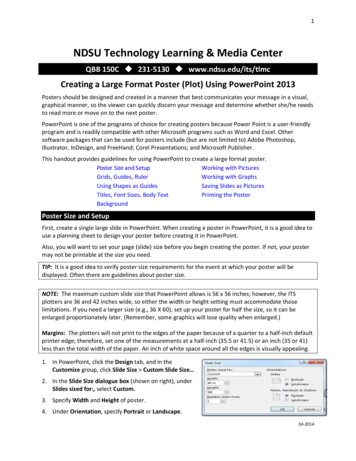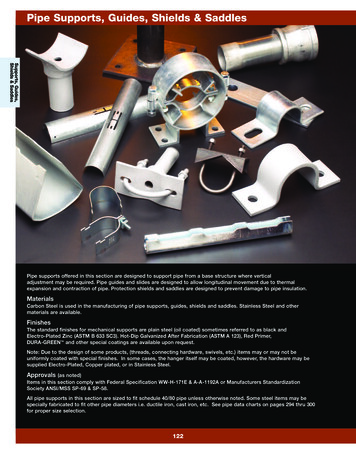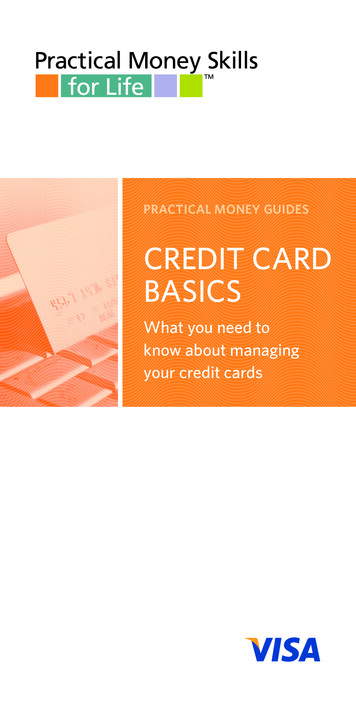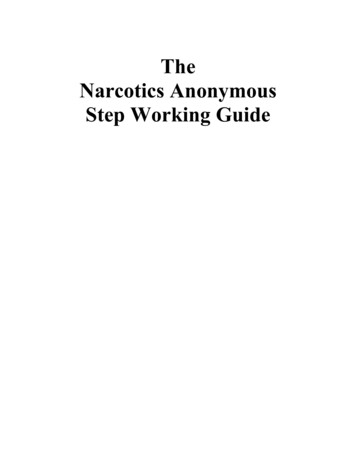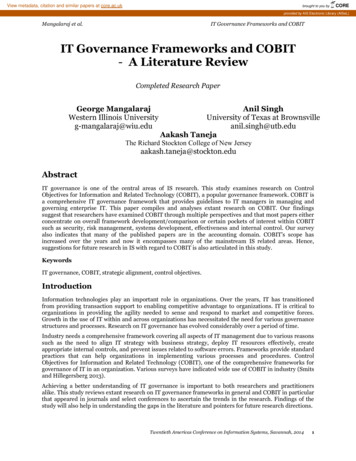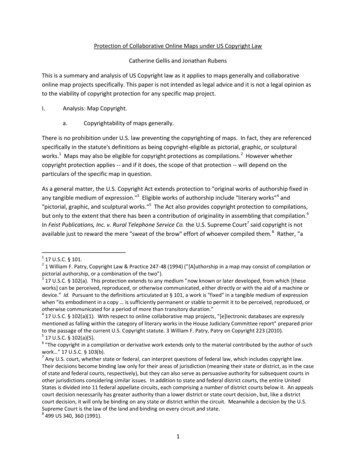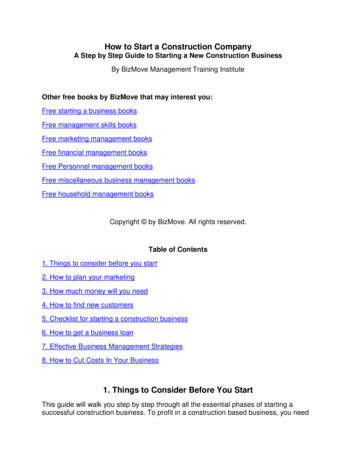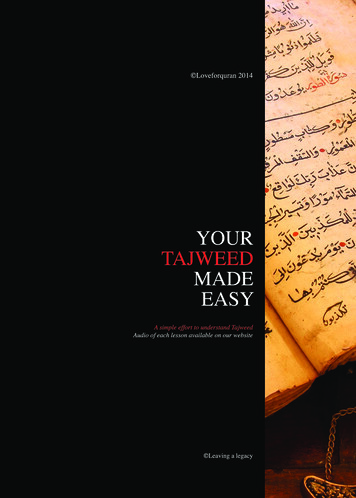
Transcription
“Whoever guides others to dogood, his reward is like the onewho does it”(Musnad Ahmad)
YOUR TAJWEED MADE EASYA step by step guide to basic Tajweed rulespage 1page 2page 3page 4page 5page 6page 7page 8page 9page 10page 11page 12page 13page 14page 15page 16page 17page 18page 19page 20page 21page 22page 23page 24page 25page 261 P ageLOVEFORQURAN.COM leaving a legacyCopyright www.loveforquran.com 2012In this booklet.My intention.Introduction.My Alphabet.A little help.My Alphabet explained.My Alphabet explained (2).Full Mouth letters.Throat letters.Lengthen for 1 second .Lengthen for 1 second (2).Lengthen for 2 – 3 seconds.Lengthen for 4 and 5 seconds.The Difference 1 and 2.Nasal Sound (ghunnah).Echo letters (qalqalah).The word Allah and letter Raw.Signs of stopping (waqf).End of a verse (waqf).Noon saakin and Tanween.Iz-haar and Iq-laab.Id-ghaaam.Ikh-faa.Meem saakin.For your information.My Appreciation .PLEASE DO NOT CHANGE ANY OF THIS DOCUMENTIN THIS BOOKLET
YOUR TAJWEED MADE EASYA step by step guide to basic Tajweed rulesMy Intention.PLEASE DO NOT CHANGE ANY OF THIS DOCUMENTFrom a simple thought to the finishedproduct in your hand I thank and Praise Allah(SWT) for the blessings HE (SWT) has bestowed upon me.I want to make a firm intention that thisproject is for Allah (SWT) alone and thereward for this project goes to:Copyright www.loveforquran.com 2012My Messenger,My Teachers,My Parents,My Wife,My Children,My Family,And My Ummah,To all those who have passed awayand to all those who are yet to come,till the final day. Aameen2 P ageLOVEFORQURAN.COM leaving a legacy
YOUR TAJWEED MADE EASYA step by step guide to basic Tajweed rulesINTRODUCTIONSimplicity is the key to move forward, user friendly documents and easily accessible information.This whole document has MP3 recordings to accompany every lesson which can be found on ourwebsite www.loveforquran.com. This booklet is for course number 3 on our website, please have alook, a listen and benefit from our resources.It is very important that this booklet be taught by a qualified teacher who has understood to abasic level what all the rules are and where to apply them.Tajweed literally means ‘to make better or to beautify’. Islamically speaking it means ‘To pronounceevery letter correctly with all its qualities’. The importance of this topic is clearly explained on ourwebsite under the tab ‘Why Tajweed?’ The arabic language is a very sensitive and delicate language,even the smallest of change in the text can affect the translation a lot.Please remember it is not only your Quran that can get affected but equally your Salaah (prayer). Ifyou do not know the basics of Tajweed then there will be serious deficiency in your prayer. For thisreason we also have a course on how to pronounce your prayer correctly on our website.The most important thing is not to move forward if you haven’t understood, if you keep movingforward without really getting to grips with what you have studied then it will cause you problems inthe future. You will have to return back to the same lessons and study them, so don’t you think itwould be wise to take extra time on each lesson in the first place?We pray to Almighty Allah (SWT) that this booklet and other resources that we have made aresincerely to benefit the ummah and to please HIM (SWT). We ask for forgiveness from Allah (SWT)for the mistakes that we have made and for the times we didn’t turn to HIM (SWT) for guidance.If you see any mistakes or have any feedback for us please be kind enough to let us know oninfo@loveforquran.com.Last thing, please visit our website and spread the message far and wide. May Allah (SWT) grant youall love for HIS book. I again thank Allah (SWT) for his kindness and mercy.A Student of Knowledge.3 P ageLOVEFORQURAN.COM leaving a legacyCopyright www.loveforquran.com 2012I praise Allah (SWT) the Most High and send blessings upon the best of creation. We pray that youare in the best of health and eemaan. Love for Quran is always looking at ways of improving andmoving forward. This booklet is an attempt to look at the subject of Tajweed. This is a very humbleeffort to address this topic at a very basic level.PLEASE DO NOT CHANGE ANY OF THIS DOCUMENTAs-salaamu-a-laykum
YOUR TAJWEED MADE EASYCopyright www.loveforquran.com 2012PLEASE DO NOT CHANGE ANY OF THIS DOCUMENTA step by step guide to basic Tajweed rulesAudio for this alphabet on WWW.LOVEFORQURAN.COM AND CHOOSE COURSE 2.4 P ageLOVEFORQURAN.COM leaving a legacy
YOUR TAJWEED MADE EASYCopyright www.loveforquran.com 2012PLEASE DO NOT CHANGE ANY OF THIS DOCUMENTA step by step guide to basic Tajweed rules5 P ageLOVEFORQURAN.COM leaving a legacy
YOUR TAJWEED MADE EASYA step by step guide to basic Tajweed rulesMY ALPHABET EXPLAINED (MAKHAARIJ)Let us now look at singular letters of the Arabic alphabet and how to say them. Wehave tried to give an English equivalent where possible but unfortunately for someletters it is not possible.BAA – from the inner part of the lips when they meet (moist part), similar to theEnglish word bar.TAA – tip of tongue touches the gums behind the front upper central two teeth(incisors).THAA – tip of the tongue touches the bottom edge of the front upper central twoteeth, similar to the English word think, thank, and threw.JEEM – centre of the tongue touches the palate, similar to the English word jeep butwith an m on the end.HAA – comes from the centre of the throat pushing air out.KHAW – comes from the top of the throat. This letter is pronounced full mouth.DHAAL - tip of tongue touches the gums behind the front upper central two teeth.ZHAAL - tip of the tongue touches the bottom edge of the front upper central twoteeth, similar to the English word the, then, they.RAW – tip of the tongue touches the upper hard palate at the front, similar to theEnglish word raw. This letter is pronounced full mouth and on occasion empty mouth.ZAA – bring your teeth together and release, similar to the English word zap and zoo.SEEN – bring your teeth together and release, similar to the English word seen.SHEEN - centre of the tongue touches the palate, similar to the English word sheet.SAWD – bring teeth together and release, somewhat similar to the English wordmuscle. This letter is pronounced full mouth (slight whistling sound).6 P ageLOVEFORQURAN.COM leaving a legacyCopyright www.loveforquran.com 2012ALIF - from the emptiness of the mouth.PLEASE DO NOT CHANGE ANY OF THIS DOCUMENTThere are 29 letters of the alphabet and below is the information on how topronounce each one.
YOUR TAJWEED MADE EASYA step by step guide to basic Tajweed rulesDHAWD - upturned side or sides of the tongue to touch the gums of the upper backteeth (molars). This letter is pronounced full mouth.TAW - tip of tongue touches the gums behind the front upper central two teeth. Thisletter is pronounced full mouth.GHAYN – comes from the top of the throat like KHAW, similar to a gargling sound.This letter is pronounced full mouth.FAA - bottom edge of the upper front teeth meets the inner bottom lip, similar to theEnglish word farm.QAWF – raising the back end of the tongue touching the palate. This is a full mouthletter.KAAF - raising the back end of the tongue touching the palate similar to QAWF but alittle further forward on the tongue, similar to the English word cart.LAAM – tip of the tongue touches the palate, similar to the English word lama(animal).MEEM – joining the outer dry part of the lips together, similar to the word the Englishword meet.NOON – tip of the tongue touches the palate, similar to the English word noon.WOW – partial meeting of the lips, similar to the English word wow.HAA – comes from the bottom of the throat close to the chest, similar to the wordheart.HAMZA – comes from the bottom of the throat close to the chest. This letter is knownas hamza but is pronounced as an alif. The best way to remember hamza is to classis as an alif, similar to the English word at.YAA – centre of the tongue touches the palate, similar to the English word Yard.WE HOPE THE ABOVE INFORMATION HAS BEEN OF SOME BENEFIT TO YOU, TO LISTEN TO ARECORDING OF HOW TO SAY EACH LETTER PLEASE VISIT OUR WEBSITE AND ACCESS COURSE 2.7 P ageLOVEFORQURAN.COM leaving a legacyCopyright www.loveforquran.com 2012AYN – comes from the centre of the throat like the HAA mentioned before, similarto the English word Einstein.PLEASE DO NOT CHANGE ANY OF THIS DOCUMENTZHAW - tip of the tongue touches the bottom edge of the front upper central twoteeth. This letter is pronounced full mouth.
YOUR TAJWEED MADE EASYA step by step guide to basic Tajweed rulesLESSON 1 FULL MOUTH LETTERSNote: If the letter ( )ر has a fatha (zabar) or dhamma (pesh) then it will be read full mouth. ـخ ُر ُج ْ َ ي ُخلِ َق ا َْصب َ َح ْت فَ ْض ِل ِ صح ف ُ ُ ا َْظل َ َم يَغ ْ ِف ُر ِ ُظلُم ات َ بَ ْط َش اَقْ َو ُم ُض ِر َب ِ ُط ْور ُغ ِف َر ُقتِل َ ْت ا ِخ ِر ِص َر َاط َر ِض َي ُع ِّ ِطل َ ْت يُعْ ِظ ْم ِ ْ َ غ ي بَقِ َي َخال ِ ِدي ْ َن َصلو ِة َض َر َب َطال ِ ُب َظال ِ ُم غَال ِ ُب َخل َ َق خ ص ض ط ظ غ ق Remember that even though a kasra (zer) comes underneath any full mouth letter that doesn’tmean that it won’t be read full mouth. )Alif will be read full mouth if it is after a full mouth letter(.The quality of the full mouth will only remain on the full mouth letter, be careful that the letterbefore or after the full mouth letter is not pronounced full mouth.These letters are known as Huroof Tafkheem (full mouth letters).8 P ageLOVEFORQURAN.COM leaving a legacyCopyright www.loveforquran.com 2012 خ صض ط ظ غ ق PLEASE DO NOT CHANGE ANY OF THIS DOCUMENTThese 7 letters will always be read with a full mouth in all states
YOUR TAJWEED MADE EASYA step by step guide to basic Tajweed rulesLESSON 2 THROAT LETTERSThese 6 letters are all pronounced from the throat. (Alif with harakah is also hamza) بَعْ ِد ـح ُف ْوظ ْ َم يُغ ْ ِنـ ْي ا َْخ ََلق ش َْي ء ـم َزة َ ُه ا َ ُع ْو ُذ ُح ْور ُغ ِف َر ُخ ُر ْوج ي َ ْو َمئِذ عَلَي ْ ِه ْم َسعِ ِه ْم َْ َج ِحي ْ َم َصغِ ْي بَ ِـخ َل ءَ اِذَا اَثْقَالَـهَا اَنْعَ ْم َت ـح ْم ُد َ ْ اَل َغ َضب َخ ِس َر ء BOTTOM OF THROAT هـ BOTTOM OF THROAT ع MIDDLE OF THROAT ح MIDDLE OF THROAT غ TOP OF THROAT خ TOP OF THROATRemember all the throat letters need to be practised a lot, at the beginning the sound that you needwill not be there but as you keep repeating it, it will get much better.We need to pay special attention to the ح and هـ because there is a clear difference (practice).Remember the throat is split into 3 sections, top, middle and bottom. The first 2 letters above arebottom, the 2nd 2 letters are middle and the 3 rd 2 letters are from the top of the throat.These letters are known as Huroof Halqi (throat letters).9 P ageLOVEFORQURAN.COM leaving a legacyCopyright www.loveforquran.com 2012َِ اذَا َجآء اِ ْه ِدنَا PLEASE DO NOT CHANGE ANY OF THIS DOCUMENT ء هـ ع ح غ خ
YOUR TAJWEED MADE EASYA step by step guide to basic Tajweed rulesLESSON 3 LENGTHEN FOR 1 SECOND (1)If you see fatha (zabar) before an alif or a kasra (zer) before a yaa or a dhamma (pesh) before a wowthen lengthen the sound for 1 second. ثِـ ْي - تِـ ْي - بِـ ْي Note: The use of 1 second length is just a guide, lengthening has to be taught by a teacher. ع َ َذاب فِيْهَا اَلِيْم َح ِسيْبًا قَال ُ ْوا يَعْل َ ُم ْو َن ِص َر َاط ل ِ َسعْيِهَا ا َل َِّ ِذي ْ َن فِيْهَا َك َف ُر ْو ُد ْو ِن اِ ْه ِدنَا ال َ َ ق ُم ْستَقِي ْ َم َج ِحي ْ َم يُنْ ِف ُق ْو َن ا َمنُ ْو اك َ َِّ اِي َا ِدي ْ ِن ُمـ ِحيْط َمغ ْ ُض ْو ِب َ ِ ْي بِـ ِه َما AnyLetterAnyLetter ُ َ ْو AnyLetter ن ُ ْور The thing that needs to be understood in this lesson is that fatha (zabar) is connected to alif,Kasra (zer) is connected to yaa and dhamma (pesh) is connected to wow.Many times the examples are read too short, don’t forget to lengthen for 1 second.Try not to over lengthen the letter too because many people do this and the reason is that they arethinking of what the next letter is and in doing so start to lengthen everything.These 3 examples are known as Madd Asli.10 P a g eLOVEFORQURAN.COM leaving a legacyPLEASE DO NOT CHANGE ANY OF THIS DOCUMENT ثَا - تَا - بَا Copyright www.loveforquran.com 2012 ث ُْو - ُت ْو - ُب ْو
YOUR TAJWEED MADE EASYA step by step guide to basic Tajweed rulesLESSON 4 LENGTHEN FOR 1 SECOND (2)If you see any one of the following 3 signs on a letter then lengthen that sound for 1 second.Standing fatha (karri zabar), standing kasra (karri zer) and upside down dhamma (ulti pesh). ُق ْران ايتِه اُ ِِّمه اِ ْم َراَتَه نَا ِديَه نَفث ِت ِ ب َ كت ه ِذه ا َْهلِه َ دَاود نِعْ َمتَه َرزَقْن ُه ْم ا َ ْصح ُب ال ِف ِه ْم َظهْ ِره ِكتبَه فِصلُه ا ِخ َر ِة ادَ َم ن َ ْف ِسه بِي َ ِده ي َ َره َح ْولَه َAnyLetterAny letter with standingFatha (karri zabar) on itَAnyLetterAny letter with standingKasra (karri zer) under itَAnyLetterAny letter withUpside downDhamma (ulti pesh) on itThe key thing to remember is lengthen each example above for 1 second.The sound has to be longer than just a fatha (zabar), kasra (zer) and dhamma (pesh) on a letter.When you pronounce the following examples there should be a clear difference: ِكتبَه - ِكتَب َ ُه ه ِذه - َه ِذ ِه ا ِخ َر ِة - ا َ ِخ َر ِة 11 P a g eLOVEFORQURAN.COM leaving a legacyPLEASE DO NOT CHANGE ANY OF THIS DOCUMENT عَل ََسوت - ا ِخ ِر - ك َ ِ ذل قَ ْو ِمه - ن َ ْف ِسه - بِه Copyright www.loveforquran.com 2012 اِن َِّه - َمالُه - لَه
YOUR TAJWEED MADE EASYA step by step guide to basic Tajweed rulesLESSON 5 LENGTHEN FOR 2-3 SECONDS اَل َِّ ِذ ْۤى ا َْطعَ َم ُه ْم َما ۤا َْعب ُ ُد Lengthen the circled area for 2-3 seconds in each exampleِ ِ َ ب َ ك َ َِّل ۤا َِّن كت ۤ تَ ْد ُع ْونَنَا ِ ه ۤ ُؤ َلء اِ ۤل ا َْهلِه َمعَ ۤه ك َ َو َما ۤا َدْر نۤ اِ ْسرآءِي ْ َل ْ ِ َ ب فِيْهَا ۤا َْحقَابًا ۤ بِايتِنَا ۤ تَ ْر ِج ُع ْو ََنَا ِمنْهَا ۤاُ ِعي ْ ُد ْوا ۤ ا َْو َحيْنَا عَب َ َس َوتَ َو ۤل ۤ َظ نَنَِّا فَقَال ُ ْوۤا ۤ اِ َِّّنَا ا َْطعَ َم ۤه ۤ َخ َزنَتُهَا It is very important that you learn the difference between the 2 types of Madd below:ِ ا آء اج ذ َََLong Madd – thick and semi-circle – 4 seconds in length َما ۤا َْعب ُ ُد Short Madd – thin and wavy – 2-3 seconds in length12 P a g eLOVEFORQURAN.COM leaving a legacyCopyright www.loveforquran.com 2012 فَ ََل ۤاُقْ ِس ُم PLEASE DO NOT CHANGE ANY OF THIS DOCUMENTThere are a couple of types of lengthening, these are called Madd.The short madd is 2-3 seconds in length and looks like a wavy line and is thin in appearance.
YOUR TAJWEED MADE EASYA step by step guide to basic Tajweed rulesLESSON 6 LENGTHEN FOR 4 SECONDS ا َْولِيآ ُءﺡ Lengthen the circled area for 4 seconds in each example ُشهَ َدآءَ ُك ْم ا ََْسَآ ُء َ َول َ ْو َشآء َم ْن يَِّ َشآ ُء ِِ السمآء َ َِّ م َن قَآ ِئ ًما LESSON 7 LENGTHEN FOR 5 SECONDSThere are a couple of types of lengthening, these are called Madd.If you find a long madd on a letter and the letter after that has a tashdeed or sukoon on it,Then the length of this is 5 seconds.ِ ي َ ْ ِّ َظآن ك َ َحآ َِّج ِ يﺡ َ ْ ِّ َضآل Lengthen the circled area for 5 seconds in each example بِ َضآ ِِّر ِه ْم َضآ ًِّل ً َخآ َِّصة آل ْئ َن َجآ ِّن ً ك َآفَِّة Remember in lessons 5, 6 and 7 it is important to lengthen for the right amount of time. Practice.13 P a g eLOVEFORQURAN.COM leaving a legacyCopyright www.loveforquran.com 2012 لِقَـآءَنَا َس َوآء PLEASE DO NOT CHANGE ANY OF THIS DOCUMENTThere are a couple of types of lengthening, these are called Madd.The long madd is 4 seconds in length and looks like a semi-circle and is thick in appearance.
YOUR TAJWEED MADE EASYA step by step guide to basic Tajweed rulesLESSON 8 THE DIFFERENCE (1) ي َ ْو َمئِذ - َم ْو ِت - ً تَ ْوبَة - ا َْو Lengthened for a secondDo not lengthen (quick sound)Take a look at these examples and figure out which is short and which is lengthened تَ ْس ُكنُ ْو َن ي َ ْوم يَعْب ُ ُد ْو َن ُم ْؤ ِمنُ ْو َن قَ ْو ُمنَا يَلْقَ ْو َن LESSON 9 THE DIFFERENCE (2)Look at the examples below and look at what is lengthened and what is not. عَلِيْم - َوقِي ْ َل - ا َ ِخي ْ ِه - اِ ْي بَيْن َ ُه َما - َه َديْنَا - لَيْ َس - ا َْي Lengthened for a secondDo not lengthen (quick sound)Take a look at these examples and figure out which is short and which is lengthened ِدي ْ ِن ُك ْم بَنَيْنَا بِ َديْن يلَي ْ َت َش ِهيْد َسبِي ْ ِل After these 2 lessons look into the Quran for more examples. Do not move to the next lesson untilyou have completely understood what the differences are in all the examples provided above.14 P a g eLOVEFORQURAN.COM leaving a legacyCopyright www.loveforquran.com 2012 ُق ُع ْود - تَ ُك ْو ُن - ي َ ُس ْو ُم ْو َن - اُ ْو PLEASE DO NOT CHANGE ANY OF THIS DOCUMENTLook at the examples below and look at what is lengthened and what is not.
YOUR TAJWEED MADE EASYA step by step guide to basic Tajweed rulesLESSON 10 NASAL SOUND (GHUNNAH) ِمنَِّا - اِن ِّ ََك - اِن َِّا - اِ َِّن Meem with tashdeedNoon with tashdeedTake a look at these examples and try to put your lesson to the test كَاَن ِّ ََك َضا ِحكًا ِِّم ْن اِ َِّن ال َِّ ِذي ْ َن ِ َِّ ي الن ِ ُ ْ ا َع اس ن َ ْفس َِّماذَا ِمنْ ُه ْم ُِّم ْقت َ ِص ْد قَ ْومً َِّاما َول ِك َِّن َجهَنَِّ َم عَب ْ ًدا ِِّم ْن ِجنَِّ ِة ِس ْحر ُِّمبِ ْي بَ ِيِّنَة ِِّم ْن ِم َن النَِّا ِر ِ َِّ والن اس َIn this type of ghunnah make a very clear ‘n’ sound and lengthen for 1 second. When you pronouncethese examples or any other examples from the Quran then automatically the nasal sound willcome. Don’t try to think about the nasal sound too much, just think about the lengthening.For eg. ِجنَِّ ِة JINNNN-NA-TI اِن َِّه INNNN-NA-HOO َجهَنَِّ َم JA-HANNNN-NAMA15 P a g eLOVEFORQURAN.COM leaving a legacyCopyright www.loveforquran.com 2012 ُص ِّم - عَ َِّم - فَل َ َِّما - ُث َِّم PLEASE DO NOT CHANGE ANY OF THIS DOCUMENTIf anywhere in the Quran you see a Noon ( )ن or a Meem ( )م with a tashdeed on topthen lengthen for 1 second with a nasal sound.
YOUR TAJWEED MADE EASYA step by step guide to basic Tajweed rulesLESSON 11 ECHO LETTERS (QALQALAH) ْق ْط ْب ْج ْد Examples of end of verse َخل َ ْق ُ ُِمي ْ ْط ب ْ َك َس ُب ُر ْو ْج ا ََح ْد becomesbecomesbecomesbecomesbecomesExamples in a word َخل َ َق ُ ُِميْط ب َ َك َس َخلَقْنَا تَ ْط ِه ْيًا ا ََحد ل َ ْم يَلِ ْد ُب ُر ْو ِج ك َ ِ قَبْل فَ ْج ِر اُقْ ِس ُم ا َْطعَ َم ُه ْم َحبْل ََتْ ِر ْي قَ ْد اَفْل ََح ق ط ب ج د To remember the 5 letters of Qalqalah all you have to do is memorise the word below, ithas been made into one word for you and therefore is easy to remember: ُق ْط ُب َج ْد Qut-bu-jad16 P a g eLOVEFORQURAN.COM leaving a legacyCopyright www.loveforquran.com 2012Sukoon ---PLEASE DO NOT CHANGE ANY OF THIS DOCUMENTIf you see the following 5 letters in the Quran with a sukoon on top then makean echo sound. Similarly if you stop on any of these 5 letters and it becomes a saakinthen we will make an echo sound.
YOUR TAJWEED MADE EASYA step by step guide to basic Tajweed rulesLESSON 32 THE WORD ALLAHِ ُح ُد ْو ُداﷲ -َ اِ َِّن اﷲ Empty mouth if kasra before AllahFull mouth if fatha or Dhamma before AllahTake a look at these examples and figure out which are full or empty mouthِ بِاِذْ ِن اﷲ ِ ِح ْز ُب اﷲ ُ ُه َواﷲ ِ ِم َن اﷲ ِ ُد ْو ِن اﷲ ُ ث اﷲ َ َ بَع LESSON 31 THE LETTER RAWIf you see a fatha (zabar) or dhamma (pesh) on the letter raw ( )ر or on the letter before the rawif the raw is saakin, then it will be read full mouth. If you see a kasra (zer) on the raw or on theletter before the raw if the raw is saakin, then it will be read empty mouth.(please refer to the notes at the end of this booklet to see more rules related to raw) ِح ْج ِر - ِر َجال - ِر ْحل َ ُة اُذْ ُك ْر - ا َْر َس َل - ك َ ُِّ َرب Empty mouth if kasra on raw or beforeFull mouth if fatha or Dhamma on raw or beforeTake a look at these examples and figure out which are full or empty mouth ِم َن النَِّا ِر َم ْرقَ ِدنَا ا ِخ َر ِة فِ ْرعَ ْو َن ُت ْس َح ُر ْو َن ُم ْر َسل ُ ْو َن 17 P a g eLOVEFORQURAN.COM leaving a legacyCopyright www.loveforquran.com 2012ِ ِعنْ ِد اﷲ -ِ بِ ْس ِم اﷲ PLEASE DO NOT CHANGE ANY OF THIS DOCUMENTThe word Allah is read full mouth if fatha (zabar) or dhamma (pesh)are before it and empty mouth if there is a kasra (zer) before it.
YOUR TAJWEED MADE EASYA step by step guide to basic Tajweed rulesLESSON 31 SIGNS OF STOPPING (WAQF)If you see a small version of theseletters or signs then you havean option to stop or to carry onIf you see any of these in the Quran then youshould pause without breaking the breath.(only certain places in the Quran, not all) ط م قف ص صل صل ے ز ق ج س سكتة وقفة ال If you see this sign do not stopThe circle tells us it is the end of a verseLook at the 2 sets of signs circledin the example to the right.Whenever you will see thisin the Quran there will bea set of 2. Stop at eitherone of the points and not both.O ُق ْل ُه َواﷲُ ا ََحد . ج فِي ِه ج . َلريب َْ َْYou will read either:12- ب فِي ْ ْه َ ْ َل َري ب فِي ْ ِه ْ ْ َل َري These are the basic symbols that you will come across in the Quran and what to do when youactually come across any of them.Remember it is important that this is studied with a qualified teacher who can explain in more detailif the need arises.18 P a g eLOVEFORQURAN.COM leaving a legacyCopyright www.loveforquran.com 2012If you see a small version of these lettersor signs then it means you stopPLEASE DO NOT CHANGE ANY OF THIS DOCUMENTIn the Quran many times you come across little versions of the alphabet letters inbetween a verse. In this lesson we will learn what to do when you see a certainletter or a certain sign.
YOUR TAJWEED MADE EASYA step by step guide to basic Tajweed rulesLESSON 35 END OF A VERSE (WAQF)ِ ا ََح َد ِح َس اب عَلِي ْ ُم If you see a single fatha (zabar), kasra (zer) or dhamma (pesh) at the end of averse then replace it with a sukoon. َم َس ْد َش ِدي ْ ْد يُ ْول َ ْد َم َسد َش ِديْد يُ ْول َ ْد If you see kasratayn (two zer), dhammatayn (two pesh) or a sukoon at the endof a word then read as a sukoon on the last letter. اجا ُط َو ا َ اَفْ َو اجا ُطوً ى ً اَفْ َو If you see fathatayn (two zabar) at the end of a verse, whether there is an alif attachedto the word or not, take one fatha (zabar) off and read with an alif. يَغْشهَا َوال ُِّضح طه يَغْشهَا َوال ُِّضح طه If you stop on a word that ends with alif or standing alif (karri zabar)then read as it is written, no change will take place.Except standing fatha (karrizabar)on a haa eg: طه ُح َط َم ْه ي َ َر ْه بِ ْه ُح َط َم ُة ي َ َره بِه If you see a round taa ( )ة or haa ( )ه with anything on, then end as haa saakin ( ـه ْ - ) ْه 19 P a g eLOVEFORQURAN.COM leaving a legacyCopyright www.loveforquran.com 2012ِ اب عَلِي ْ ْم ْ ا ََح ْد ح َس PLEASE DO NOT CHANGE ANY OF THIS DOCUMENTMany people get very confused on how to stop at the end of a verse. In thechart provided below there are examples of how to stop correctly.
YOUR TAJWEED MADE EASYA step by step guide to basic Tajweed rulesLESSON 16 NOON SAAKIN AND TANWEEN ِم ْن – ُك نْتُ ْم - ْن Fathatayn (two zabar), kasratayn (two zer) anddhammatayn (two pesh) are known as tanweenThe circled letters are known as noon saakin(basically its a noon with a sukoon on it)Take a look at these example s and get used to the noon saakin and tanween: قَ ْومًا َجنت ِمنْ ُك ْم TanweenTanweenNoon saakinTanween اَنْتُ ْم Tanween ش َْيء ا َْن تَ ْرفَ ُع Noon saakinNoon saakin َخ ْي TanweenTanweenNoon saakinNoon saakinTanween زَيْتُ ْون ي َ ْو َمئِذ يَنْ ُص ْر ُك ْم Tanween ِديْنًا Tanween َه ْونًا Tanween ن َ ْفس اُن ْ ُظ ْر ُش ُه ْود Now that you are aware of what noon saakin and tanween look like in different words, in the nextfew lessons we will be studying a few rules related to them. Please also try to remember that thesound from noon saakin and tanween is similar, they all have the ‘n’ sound. Look at the circled partof the words above and you will see. For eg. Min-kum and Naf-sun.20 P a g eLOVEFORQURAN.COM leaving a legacyCopyright www.loveforquran.com 2012ًPLEASE DO NOT CHANGE ANY OF THIS DOCUMENTLook at the examples below and look at what a noon saakin and tanween look likethe reason for this is that if certain letters come after a noon saakin or tanween thenthere will be a rule taking place. For this lesson you just need to identify both:
YOUR TAJWEED MADE EASYA step by step guide to basic Tajweed rulesNow we will learn the 4 rules related to noon saakin and tanween.1. IZ-HAAR2. IQ-LAAB3. ID-GHAAMTHE 1 I’S4. IKH-FAALESSON 17 IZ-HAAR (TO MAKE CLEAR) اِ ْن ه َذا َوا ْْن َ ْر ش َْيء عَلِيْم عَنْ ُه عَلِيْم َخبِ ْي قَ ْومًا غَ ْيًا ِم ْن ا َْر ِض ُك ْم َم ْن ا َ ِم َن اَنْعَ ْم َت ِم ْن َغ َضب ن ُ ْو ًحا َه َديْنَا َط ْيًا ا َبَابِي ْ َل Remember an active alif is also known as hamza. Look at the last 3 examples.LESSON 18 IQ-LAAB (TO CONVERT)MEMORISE THIS: IF AFTER NOON SAAKIN OR TANWEEN YOU SEE ABAA ( )ب CHANGE THE NOON SAAKIN OR TANWEEN FOR A MEEM ( )م AND LENGTHEN FOR 1 SECOND WITH A NASAL SOUND.REMEMBER TO LEAVE THE SPACE OF A PIECE OF PAPER BETWEEN THE LIPS ا َبَ ًدا ِِبَا ِ ن م ْن بَ ِ ْى Take a look at these example s and get used to IQ-LAAB: ِم ْن بَقْلِهَا ُمنْ َف ِطر بِه ِم ْن بَعْ ِد ن َ ْفس ِِبَا 21 P a g eLOVEFORQURAN.COM leaving a legacyCopyright www.loveforquran.com 2012Take a look at these example s and get used to IZ-HAAR:PLEASE DO NOT CHANGE ANY OF THIS DOCUMENTMEMORISE THIS: IF AFTER NOON SAAKIN OR TANWEEN YOU SEE ANY OF THE6 LETTERS OF THE THROAT ( خ ، غ ، ح ، ع ، هـ ، ) ء THEN READ CLEARLY WITH NO CHANGE
YOUR TAJWEED MADE EASYA step by step guide to basic Tajweed rulesLESSON 39 ID-GHAAM (TO MERGE)MEMORISE THIS: IF AFTER NOON SAAKIN OR TANWEEN YOU SEE ANYOF THE 4 LETTERS ي , ن , م , و JOIN THE LETTERS AND LENGTHENFOR 1 SECOND WITH A NASAL SOUND.Take a look at these example s and get used to ID-GHAAM: ِم ْن ن ِّ ُْطفَة ِم ْن َِّما ۤء َطآ ِئ َفةً ِِّمنْ ُه ْم َو َوالِد َِّو َم َاول َ َد َخ ْيًا يِّ ََره َجا ِم َدة ً َِّو ِه َي ي َ ْو َمئِذ ن َِّا ِع َمة َويْل يَِّ ْو َمئِذ ِ ِّ ع َا ِملَة ن َاصبَة ِسنَة َِّو َل ن َ ْوم َم ْن يَِّ َشا ۤ ُء ِم ْن َِّو َرا ۤءِ ِه ْم َكعَ ْصف َِّما ْ ُك ْول ي َ ْو َمئِذ يَِّ ْص ُد ُر َِ َحيْد َِّّمِيْد Example of how to pronounce and what part of the word to stretch.REMEMBER – STRETCH THE NOON SAAKIN OR TANWEEN WITH WHATEVER IT IS JOINT TO.ِ اول َ َد َ َو َوالد َِّو َم WA WAALI-DIUUUUU WA MAA WALADTHERE ARE CERTAIN WORDS IN WHICH THERE IS A NOON SAAKIN AND ONE OF THE 4 LETTERSABOVE BUT WE DO NOT MAKE ID-GHAAM (DON’T JOIN AND STRETCH) BECAUSE THE NOON SAAKINAND ONE OF THE LETTERS ABOVE ARE BOTH IN ONE WORD. FOR EXAMPLE: ِصن ْ َوان قِن ْ َوان ُب نْيَان ُدنْيَا 22 P a g eLOVEFORQURAN.COM leaving a legacyPLEASE DO NOT CHANGE ANY OF THIS DOCUMENT ( ي َنْ ُم ْو YANMOO) TO HELP YOU WITH THE 4 LETTERSCopyright www.loveforquran.com 2012REMEMBER THE WORD
YOUR TAJWEED MADE EASYA step by step guide to basic Tajweed rulesLESSON 20 IKH-FAA (TO HIDE)REMEMBER TO HIDE THE ‘N’ SOUND FROM THE NOON SAAKIN AND TANWEENTake a look at these example s and get used to the noon saakin and tanween: ِم ْن ُج ْوع لَيْلَةً ُث َِّم فَ َم ْن ُز ْح ِز َح ن َ ْفس ذَ ِآئقَ ُة ا َْن دَعَ ْو ُت ُك ْم ِر َجال َص َد ُق ْوا ع َ َذابًا َش ِدي ْ ًدا ََخْ َسة َسا ِد ُس ُه ْم ِظ ًَِّل ًظلِي ْ ًَل ِم ْن ِط ْي ُق َِّوة ُضعْفًا ِ ان َ َ فَا ْن ك َو َم ْن قَت َ َل ِ َح َسنَة فَ ِم َن اﷲ ج Example ز Example ص Example ظ Example ك Example ث Example ذ Example ش Example ط Example ق Example اَنْتُ ْم ت Example د Example س Example ض Example ف ExampleNOTE: THE EASIEST WAY TO REMEMBER THESE LETTERS IS TO USE THE SECTIONS ON EACH FINGER, THAT WAYTHE FULL HAND EQUALS 15 SECTIONS AND WE HAVE 15 LETTERS.23 P a g eLOVEFORQURAN.COM leaving a legacyCopyright www.loveforquran.com 2012، ك ، ق ، ف ، ظ ، ط ، ض ، ص ، ش ، س ، ز ، ذ ، د ، ج ، ث ، ت PLEASE DO NOT CHANGE ANY OF THIS DOCUMENTMEMORISE THIS: IF AFTER NOON SAAKIN OR TANWEEN YOU SEE ANY OFTHE FOLLOWING 15 LETTERS MAKE A LIGHT NASAL SOUND ANDLENGTHEN FOR 1 SECOND.
YOUR TAJWEED MADE EASYA step by step guide to basic Tajweed rulesLESSON 23 MEEM SAAKIN (IKH-FAA SHAFAWI)MEMORISE THIS: IF AFTER MEEM SAAKIN YOU SEE THE LETTER ( )ب MAKE A LIGHT NASAL SOUND AND LENGTHEN FOR 1 SECONDWITHOUT BRINGING THE LIPS COMPLETELY T
bottom, the 2nd 2 letters are middle and the 3rd 2 letters are from the top of the throat. These letters are known as Huroof Halqi (throat letters). LESSON 2 THROAT LETTERS These 6 letters are all pronounced from t

